Processing: The Cognitive Channels
Words to know for chapter 5:
Process - how your brain uses information
Compensate - using a strength to make up for a weakness
Storage - putting something away for safe keeping
Retrieval - getting something out of storage
Sensory - using your senses (sight, hearing, touch, smell, taste)
Cognitive - using your brain
Sequencing - putting details in order
Rational - piece by piece
Conceptual - understanding concepts and deep meaning
Holistic - looking at the 'whole thing' instead of the parts
Inferential - using your mind to 'fill in' missing information
Channel - a path used for information to travel
Modality - a method used for processing information
'Now let's go deeper into the brain!'
The 2 main cognitive processing channels:
After information is processed through the sensory channels, it is passed along to the cognitive processing areas for further understanding, storage (memory), and later retrieval. Although there are thought to be many different specific types of cognitive processing, research about the brain suggests that two of the most important processing areas are found in the two sides or 'hemispheres' of the brain. Let's look closely at these processing areas:
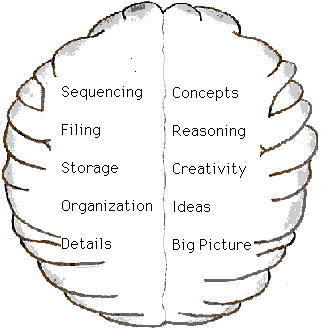
Left-brain:
Sequential/organizational processing is the main filing system in your brain and is done in the left hemisphere. It involves organizing and memorizing specific bits of information including facts, figures and formulas.
This is very much like a computer organizes and stores information. How well do you remember details (like names, addresses, facts, etc.)? How organized are you?

Right-brain:
Conceptual/holistic processing involves looking for 'the big picture', overall patterns and underlying concepts for use in higher-order thinking, creating, and reasoning.
Conceptual/holistic filing is like throwing things into boxes with very general labels. Do you see 'the big picture'? Do you understand general ideas? Are you creative and inventive?

In general, the right side of the brain does most of the thinking, reasoning, and creating. The left side organizes these thoughts and ideas for efficient storage and expression.
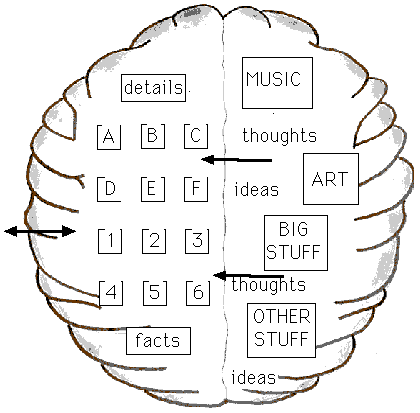
For most people, both sides of the brain work together very well. But for many LD students, one half of their brain works much better than the other half. This causes problems learning certain kinds of information.
For example, if your right brain works much better (or faster) than your left brain, you have lots of wonderful ideas but can't get them organized well (or fast enough) for expression (especially in writing).
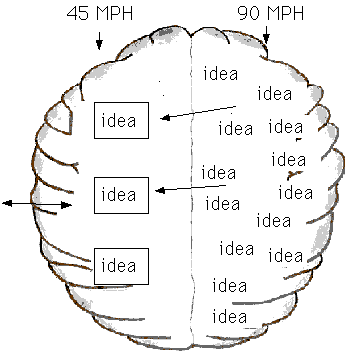
On the other hand, if your left brain works better (or faster) than your right brain, you are very good at memorizing and organizing details but have trouble generating new ideas or understanding concepts.
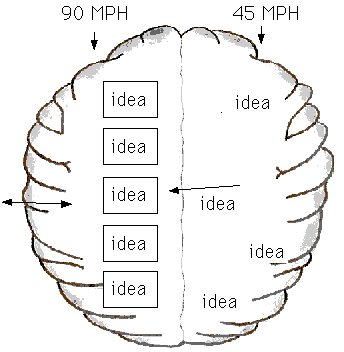
Now let's see how these two processing areas affect learning.
Sequential/Organizational (left-brain) processing includes:
- Short-term memory for details
- long-term retrieval of details
- fine-motor coordination
- finding the words you want to say or write
- organization of your thoughts and materials
- writing mechanics (spelling, punctuation)
- reading speed/sounding out new words
- attention to details
- putting words and thoughts in order
People experiencing a general Sequential/Organizational disability often have most learning difficulties in the areas of basic reading, math computation, expressive language, and writing mechanics. Specific difficulties may include:
- handwritingspeed/clarity- reading
letter reversals
spelling/mechanics
letters in wrong sequence (order)decoding (sounding our words)- math
speed/fluency
remembering details
attention/concentrationremembering formulas/steps- communicationfinding words for verbal or written expression- generalplanning lengthy assignments
remembering details
paying attention - easily distracted by surroundings
remembering names of people or objects
following specific directions
Is sequential/organizational processing a strength or weakness for you?
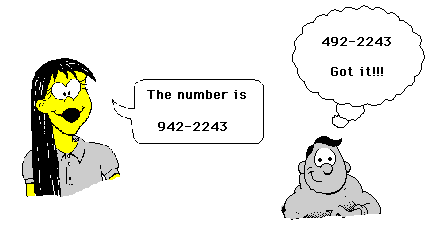
Conceptual/Holistic (right-brain) processing includes:
- memory for general themes or ideas
- reasoning
- spatial awareness
- general knowledge
- inferential thinking
- estimation/approximation
- conceptual understanding
- creativity/inventiveness
- reading comprehension
- use of context
- rhythm
- music
- art
People experiencing a general conceptual/holistic processing disability often perform quite well during early school years but later experience much difficulty with reading comprehension, math reasoning, and creative writing. Specific difficulties may include:
- readingunderstanding irony, inferences, sarcasm- math
general comprehensiongeneralizing to new situations- written language
story problemscreative writing- communicationgeneral language comprehension- general
understanding humorglobal/general awareness
attention - may focus too much on a specific area
Is conceptual/holistic processing a strength or weakness for you?
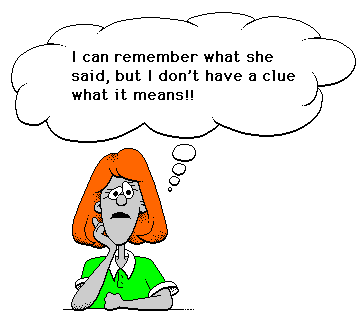
The final processing area for us to explore is Processing Speed. This refers to how fast information travels through your brain.
All LD students experience some processing speed difficulty when required to process information through their weakest 'channel' or 'modality'. But for other LD students, a general weakness in processing speed causes difficulty in all modalities.
It is like having your brain work at 40 miles per hour when the rest of the world (and all the information around you) is going 55 miles per hour. You just can't keep up.
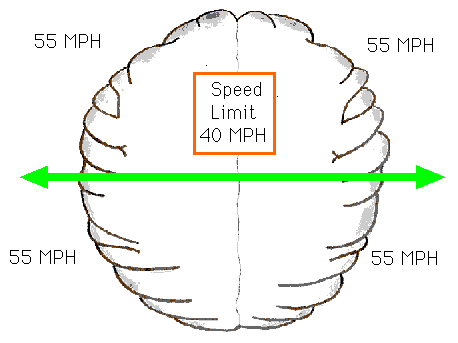
Processing Speed affects:
- short-term memory (with time pressure)
- long-term retrieval (with time pressure)
- talking speed, word-finding
- writing speed
- reading speed
- attention
- reasoning (with time pressure)
- general response speed
People experiencing a general Processing Speed disability often have learning difficulties in all academic areas due to their inability to process all types of information quickly. Specific difficulties may include:
- readingreading speed- math
ability to stay focused while readingcompleting a series of problems- written languagewriting speed- communication
mechanics
clarity (with time pressure)delays in responding- general
slow, deliberate speech
word-finding difficultiescoping with implied or expressed time pressures
always 'a step behind'
difficulty maintaining attention to tasks
exceeding time limits during tests
trouble with social pressures to perform 'faster'
Is processing speed a strength or weakness for you?
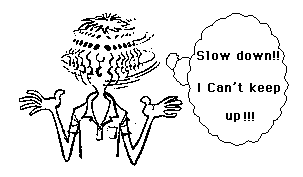
Review Questions:
1. What are the two 'cognitive' areas of information processing discussed in this chapter?
2. Which side or 'hemisphere' of the brain is most responsible for 'conceptual' processing ?
3. Which cognitive processing modality is best used for memorizing specific facts?
4. Which cognitive processing modality is most 'creative' at developing new ideas or inventions?
5. What is meant by 'inferential thinking'?
6. Why does 'processing speed' affect all LD students?
Uncovering the Mysteries of your Learning Disability
Order printed copies of this manual
- Chapter 1 - What is a Learning Disability?
- Chapter 2 - What Causes Learning Disabilities?
- Chapter 3 - Discrepancy = Underachievement
- Chapter 4 - Processing: The Sensory Channels
- Chapter 5 - Processing: The Cognitive Channels
- Chapter 6 - Processing: Sensory + Cognitive
- Chapter 7 - LD Jargon
- Chapter 8 - Using Accommodations
- Chapter 9 - Other Issues Related to LD
- Chapter 10 - Intelligence vs IQ
- Chapter 11 - Exercizing Your Weakness
- Chapter 12 - LD and the Law
- Chapter 13 - Becomming an Effective Self-Advocate
- Chapter 14 - Planning for Your Future
- Chapter 15 - The Summary
Copyright © 2006-2017 LDinfo Publishing
All rights reserved. Any reuse or republishing of the text
or images on this web site without prior written consent of
the copyright holder is prohibited.